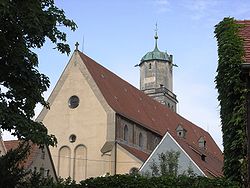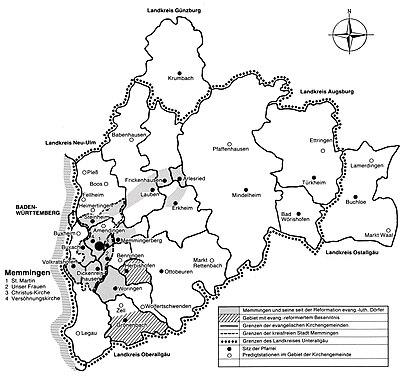Evangelical Lutheran Dean's Office Memmingen
|
Evangelical Lutheran Dean's Office |
|
|---|---|
 Deanery Church St. Martin in Memmingen |
|
| organization | |
| Deanery district | Memmingen |

|
|
| Church district | augsburg |
| Regional church | Evangelical Lutheran Church in Bavaria |
| statistics | |
| surface | 1610 km² |
| Parishes | 18th |
| Parishes | 20 Lutheran 2 reformed |
| Parishioners | 31,799 (December 31, 2009) |
| management | |
| Address of the Dean's Office | Zangmeisterstraße 13 87700 Memmingen |
| Web presence | www.memmingen-evangelisch.de |
The Evangelical Lutheran deanery Memmingen is one of seven deanery districts of the Augsburg church district of the Evangelical Lutheran Church in Bavaria .
geography
The dean's office in Memmingen is located in southwest Bavaria on the state border with Baden-Württemberg . It comprises the area of the Unterallgäu district , that of the independent city of Memmingen and one municipality each from the Günzburg (Krumbach) and Ostallgäu (Buchloe) districts.
history
The imperial monasteries were important for the ecclesiastical and territorial development in Upper Swabia . To the southeast of Memmingen is the Ottobeuren monastery, founded in 764 and elevated to the status of an imperial monastery in 972 . In the north-west of Memmingen are the former imperial abbeys Rot an der Rot (founded 1126) and Ochsenhausen (founded 1090) as well as the former Imperial Charterhouse of Buxheim . The large territory of the monastery and prince monastery of Kempten, founded in 752, was located in the south of Memmingen . During the Reformation , the imperial city of Memmingen was like an island within spiritual territories. Christoph Schappeler is considered to be a reformer of Memmingen . From 1523 Schappeler could preach Lutheran unhindered. After a religious discussion in the town hall from January 2 to 7, 1525, the mass was abolished and the Lord's Supper was served in both forms. Under the influence of the Reformation, the Twelve Peasant Articles came about on March 20, 1525 .
The subsequent peasant war with the occupation of the city by the troops of the Swabian Federation brought a temporary setback for the Reformation. At the Diet of Augsburg in 1530 was from Memmingen along with the imperial cities of Strasbourg, Konstanz and Lindau Zwinglian embossed tetrapolitan confession presented. In doing so, they distanced themselves from the other evangelically-minded imperial estates that submitted the Confessio Augustana . After Zwingli's death, Memmingen took over the Confessio Augustana in 1532. With the accession to the Wittenberg Agreement in 1536, the Lutheran confession was fully accepted. In 1530 the city appointed a Protestant pastor in Steinheim near Memmingen. In 1532, other rural communities in Memmingen followed. In 1537 the imperial urban rural communities of Arlesried, Buxach, Dickenreishausen, Erkheim, Frickenhausen, Lauben, Memmingerberg, Steinheim, Volkratshofen and Woringen were officially reformed. In 1577 a Simultaneum was introduced in Volkratshofen . After the Counter Reformation in 1629, the simultaneous use of St. Stephen's Church was reverted to in 1649. In Erkheim both churches, the upper and the lower parish, had become Protestant in 1537. As a result of the Counter Reformation, both churches became Catholic again from 1628. After the restitution according to the normal year 1624 due to the provisions of the Peace of Westphalia , the upper church became Lutheran again.
In Memmingen, a superintendent was set up for the city and the rural communities after the Reformation . The superintendent was the pastor of St. Martin. Usually the superintendent had started his pastoral career in one of the rural parishes. On December 7, 1810, the Bavarian Dean's Office was established. With the influx of the displaced after the Second World War, Protestant parishes were founded in the mostly Catholic places, which led to a strong increase in the administrative work of the deanery. Before that, it was almost exclusively limited to the area of the former imperial city of Memmingen and the Zwingl communities in Grönenbach and Herbishofen. The deanery has belonged to the Augsburg parish since 1971 . Its tasks are above all the division of pastors, the administration of the church properties and the choir.
Parishes
31,799 parishioners live in the deanery (as of 2009) in 18 Evangelical Lutheran parishes with 20 parishes. In addition, there are two evangelical reformed congregations in the area of the deanery, which belong to the evangelical reformed church .
City of Memmingen
- Dean's main church St. Martin (with teaching church for children )
- Our women
- Christ Church
- Church of Reconciliation
- Buxach / Buxheim
- Sprengel Dreieinigkeitskirche in the Buxach district
- Sprengel Buxheim in the Unterallgäu district.
- Dickreishausen / Volkratshofen
- Sprengel Dickenreishausen , St. Agatha Church
- Sprengel Volkratshofen , Simultankirche St. Stephan
- St. Martin in the district of Steinheim
District of Unterallgäu
- Bad Wörishofen , Church of the Redeemer
- Erkheim , St. Peter and Paul Church (upper church)
- Frickenhausen / Arlesried
- District Frickenhausen St. Veit
- Sprengel Arlesried , St. Ursula
- Arbors , our dear women
- Memmingerberg , St. Gordanius and Epimachus Church (1483)
- Mindelheim , Johanneskirche
- Ottobeuren , Church of the Redeemer
- Türkheim , Holy Spirit Church
- Woringen , our women
District of Günzburg
- Krumbach , Gospel Church and Apostle Church
District of Ostallgäu
- Buchloe , Church of Hope
Evangelical Reformed Congregations
- Bad Grönenbach , Evangelical Reformed Church
- Herbishofen , Evangelical Reformed Church
Full-time employees
In the deanery district, 20 Evangelical Lutheran pastors are employed in the 18 parishes and 2 Evangelical Reformed pastors in the two Reformed parishes. Four pastors are in the school service, one deacon is active in church work. Ten religious educators and two catechists are assigned to religious instruction in schools in the Unterallgäu district and the city of Memmingen, and two of them also work in their parishes. 17 pastoral secretaries and 2 deanery secretaries do administrative work. Church music director and dean's cantor is Hans-Eberhard Roß .
literature
- Adolf Kemnitzer (editor): Evangelical in Unterallgäu . Legacy of the Reformation, Diaspora and Ecumenism. Ed .: Parish Conference of the Evang. - Luth. Deanery Memmingen. Verlag der Ev.-Luth. Mission Erlangen, Memmingen 1997, ISBN 3-87214-209-7 (first edition: 1986).
- Wolfgang Jahn (Ed.): Money and Faith . Life in Protestant imperial cities. House of Bavarian History, Augsburg 1998, ISBN 3-927233-59-5 .